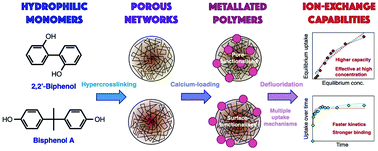Calcium-loaded hydrophilic hypercrosslinked polymers for extremely high defluoridation capacity via multiple uptake mechanisms†
Abstract
Hydrophilic hypercrosslinked porous polymer networks were synthesised from 2,2-biphenol (HHCP1) and bisphenol A (HHCP2) monomers, which were assessed for remediation of highly fluoridated water. The networks were hydrophilic and the hypercrosslinking radically altered the acidity of protonation sites within the polymeric scaffolds. The polymers were metallated to produce novel, hybrid Ca-loaded adsorbents. The metal-loading affected the electron distribution of the quinonoid structures formed during polymerisation. HHCP1 had a greater exchange capacity (6.34 ± 0.17 mmol g−1) and adsorbed more Ca2+, yet retained much of its original surface area, whereas HHCP2 was rendered non-porous upon metallation. Ca-loading included covalent interactions and formation of crystalline CaCO3 (vaterite), from preferential CO2 binding under ambient conditions. Both networks were effective defluoridating media, with Ca-loaded HHCP1 exhibiting a capacity among the highest yet reported for any extractant (267 ± 34 mg g−1). HHCP2-Ca had a lower capacity of 96.2 ± 10 mg g−1, but faster uptake kinetics and was more effective at lower concentrations, attributed to stronger binding interactions. Crystalline CaF2 (fluorite) was the dominant fluoride species formed, from both vaterite and covalently bound Ca. The networks could be used in a dynamic column system, extracted fluoride in the presence of multiple coexisting anions and were regenerable, with a potential pathway demonstrated for recovery of the adsorbed fluoride.



 Please wait while we load your content...
Please wait while we load your content...